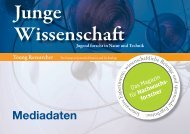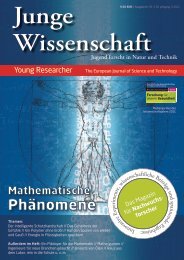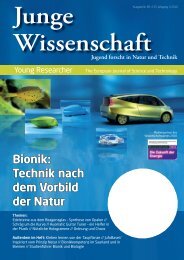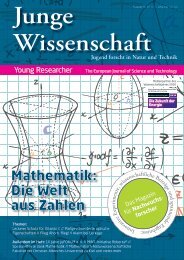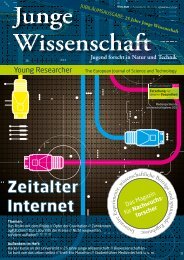2008: Das Jahr der Mathematik - Junge Wissenschaft
2008: Das Jahr der Mathematik - Junge Wissenschaft
2008: Das Jahr der Mathematik - Junge Wissenschaft
You also want an ePaper? Increase the reach of your titles
YUMPU automatically turns print PDFs into web optimized ePapers that Google loves.
Jugend forscht<br />
Jugend forscht<br />
short-term adaptation effect are similar in both<br />
types of visual areas.<br />
References<br />
[1] Avidan, G., Hason, U., Hendler, T.,<br />
Zohary, A. and Malach, R., 2002: Analysis<br />
of the Neuronal Selectivity Un<strong>der</strong>lying<br />
Low fMRI Signals. Current Biology. 12:<br />
964-972.<br />
Figure 6: Percentage of the errors in first exposure to modified image after acquiring adaptation (block 2). Two different<br />
optional error types: caused due to an image modification or a contrast modifications.<br />
[2] Barrett, B. T., McGraw P. V. and<br />
Morril, P., 2002: Perceived Contrast Following<br />
Adaptation: The Role of Adapting<br />
Stimulus Visibility. Spatial Vision. 16:<br />
5–19.<br />
[3] Carandini, M., 2000: Visual Cortex:<br />
Fatigue and Adaptation. Current Biology.<br />
10. No 16.<br />
[4] Grill-Spector, K., 2003: The Neural<br />
Basis of Object Perception. Current Opinion<br />
in Neurobiology. 13. 1–8.<br />
[5] Hubel, D. H. and Wiesel, T. N, 1968:<br />
Receptive fields and functional architecture<br />
of monkey striate cortex. J. Physiol.<br />
195: 215-243.<br />
Figure 7: Percentage of the errors in first exposure to modified image after acquiring adaptation (block 2). Two different<br />
optional error types: caused due to an image modification or a contrast modifications.<br />
the changed ones. We collected information<br />
about response times during the experiment<br />
but did not analyze it in or<strong>der</strong> to face this question,<br />
which remains open for further research.<br />
5 Conclusion<br />
We showed for the first time that short-term<br />
adaptation behavior achieved by the psychophysical<br />
experiment is correlated with the results<br />
achieved by long term adaptation experiments,<br />
and also consistent with results achieved<br />
in fMRI-adaptation experiments.<br />
Due to time limitations, only the accuracy aspect<br />
of our results was analyzed. This aspect<br />
of the results is compatible with our basic assumption:<br />
Short-term adaptation causes a decrease<br />
in the accuracy of reaction to changes<br />
in stimuli. The most ambiguous behavior was<br />
demonstrated after contrast modifications. It<br />
was found that errors due to changes in contrast<br />
level were most dominant, and thus imply<br />
that the system is aware of some change but<br />
fails to specify it.<br />
Conducting two parallel researches, one dealing<br />
with "complex" stimuli, activating<br />
high or<strong>der</strong> cortical areas, and the other with<br />
"simple" stimuli, stimulating primary visual<br />
areas, we correlate the results of the studies. This<br />
unique comparison revealed a vast resemblance<br />
in the results of the two. We therefore suggest<br />
that the behavioral mechanisms un<strong>der</strong>lying<br />
Acknowledgement<br />
We would like to extend our most humble<br />
gratitude to our helpful, friendly, and<br />
inspiring mentor Anat Herbet-Grinfeld.<br />
We would also like to acknowledge the<br />
department of Biomedical Engineering<br />
for hosting us and SciTech staff for their<br />
hard work to provide us with this great<br />
summer camp. Eszter would like to thank<br />
the Hungarian Research Student Association<br />
(Kutató Diákok Országos Szervezete)<br />
and Mr. Russel Stern. Yoni would like to<br />
thank Simcha Stern. We would all like to<br />
thank our parents for granting us the opportunity<br />
to take part in this meaningful<br />
experience.<br />
[6] Kanwisher N., McDermott J., Chun<br />
M. M. – The fusiform face area: a module<br />
in human extrastriate cortex specialized<br />
for face perception. J. Neurosci 1997,<br />
17:4302-4311.<br />
[7] Luo, J., Crandall, D., Singhal, A.,<br />
Boutell, M. and Gray, R., 2003: Psychophysical<br />
Study of Image Orientation Perception.<br />
Spatial Vision. 16: 429-457.<br />
[8] Webster, M. A., 2001: Visual Adaptation<br />
and the Relative Nature of Perception.<br />
[9] Malach R., Reppas J. B., Benson R.<br />
R., Kwong K. K., Jiang H., Kennedy W.<br />
A., Ledden P. J., Brady T. J., Rosen R.,<br />
Tootell R. B. H. – Object-related activity<br />
revealed by functional magnetic resonance<br />
imaging in human occipital cortex. Proc.<br />
Natl. Acad. Sci. USA, Vol. 92 pp. 8135-<br />
8139, August 1995. Neurobiology -3.).<br />
[10] Epstein R., Kanwisher N. – A cortical<br />
representation of the local visual region.<br />
Nature 1998 Apr 9; 392 (6676): 598–601.<br />
[11] Downing PE., Jiang Y., Schuman M.,<br />
Kanwisher N. – A cortical area selective<br />
for visual processing of the human body.<br />
Science 2001 Sep 28;293(5539):2470.<br />
36<br />
<strong>Junge</strong> <strong>Wissenschaft</strong> 79 // 1/<strong>2008</strong> // Short-term Adaption of Primary and High-or<strong>der</strong> Visual Areas



